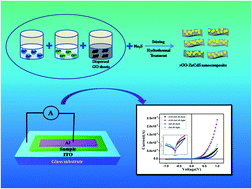Synthesis of rGO–Zn0.8Cd0.2S via in situ reduction of GO for the realization of a Schottky diode with low barrier height and highly enhanced photoresponsivity†
Abstract
A metal–semiconductor interface is an integral part of numerous electronic devices such as Schottky barrier diodes (SBDs). On the other hand, ever since graphene was isolated, there has been an impressive growth in the application of graphene to electronic devices. In this study, we present the synthesis of a reduced graphene oxide–zinc cadmium sulfide (rGO–Zn0.8Cd0.2S) composite via an in situ reduction of graphene oxide. Such a composite was applied to the fabrication of a Al/rGO–Zn0.8Cd0.2S SBD, and its performance was compared with the Al/Zn0.8Cd0.2S SBD. After current–voltage (I–V) measurements in the dark and under illumination, important diode parameters were obtained from the (I–V) characteristic curves. Due to the incorporation of graphene, the photoresponse of the Al/rGO–Zn0.8Cd0.2S SBD was enormously enhanced by 448% compared to its counterpart without rGO. Furthermore, the detectivity also increased significantly by 2 order of a magnitude. Moreover, a considerably lower barrier height of 0.16 eV was achieved with rGO–Zn0.8Cd0.2S compared to Zn0.8Cd0.2S (0.28 eV). The superior performance for the rGO–Zn0.8Cd0.2S-based SBD was analyzed and explained by the space charge limited current (SCLC) theory, which confirmed that the charge transfer kinetics improved vastly due to the incorporation of rGO. Notably, there was an exceptional 300% increase in the effective carrier mobility for rGO–Zn0.8Cd0.2S. The SCLC analysis of the charge transfer kinetics was also verified by photoluminescence and electrochemical impedance spectroscopy. These results demonstrated the beneficial impact of graphene on a Zn0.8Cd0.2S-based diode. Indeed, the rGO–Zn0.8Cd0.2S diode exhibited an impressive performance, with a considerably lower barrier height, highly enhanced photoresponsivity and detectivity. Overall, our extensive study reveals that rGO–Zn0.8Cd0.2S exhibits a great potential in the design of multifunctional optoelectronic devices.



 Please wait while we load your content...
Please wait while we load your content...